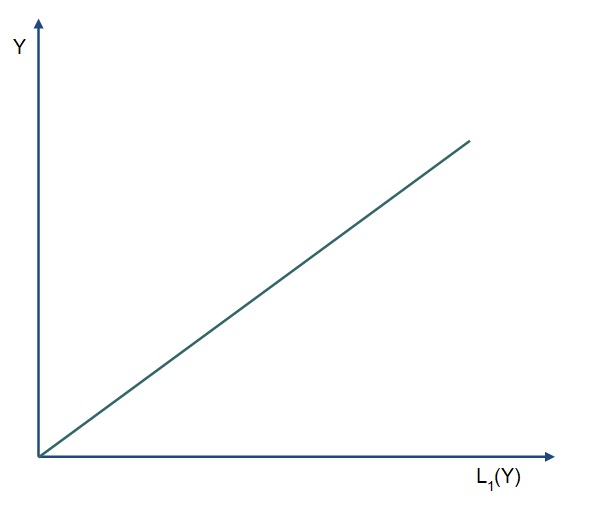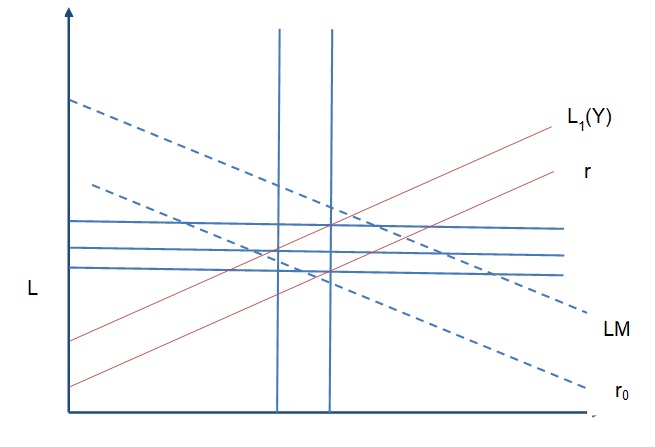Explain how a basic analysis of the money market underpins the derivation of the LM curve
The LM curve is derived from the money market equilibrium. It shows the range of values of interest rates, I, which when combined with the outputs, Y, give an equilibrium money market. The interest rate, I, can be interpreted as the opportunity cost of money i.e., payment for liquidity preference.
The money market equilibrium can be expressed as M/P = L (i, Y) = L (r, Y), where M is the money in circulation as supplied by the central bank (the Fed), while P is the price level. Based on the Keynesian model, the Fed influences the price level and interest rates by determining the amount of money in circulation; thus, at money market equilibrium, the interest rates (i.e. the nominal rate, r and the real interest rate, i) can be assumed as being equal. The money market equilibrium is reached when the real money demand, L, is equal to the real money supply, M/P. Thus, at a particular output, Y, the interest rate, I, changes so that the liquidity function, L (demand) is at equilibrium with the exogenous supply. Thus, by simplifying the liquidity function, it is possible to determine the demand for real money. There are two motives that influence demand for real money balances; the transaction/precautionary motive, which is a function of the output L1 (Y), and the speculative motive L2 (i), which depends on interest rate speculations. This can be represented graphically as shown in the LM curves below.
Given that the money supply, M determined exogenously, to achieve money market equilibrium, the sum of its supply must be equal to the sum of its demand. Thus:
(M/P) = L1 (Y) + L2 (I).
Any change in one or more of these variables causes the LM curve to shift. The demand for real money balances (speculative motive, L2) decreases as a function of interest, i. At a low-interest level, the demand for money is infinite as there is less money in circulation.
Why is the IS curve so-called and how can it be derived? Make clear the relationships that underpin IS?
In the IS curve, interest rates are represented as a function of Gross Domestic Product (GDP). The initials I.S., in full, means the investment and saving equilibrium. It represents the locus points of all equilibriums; a point where total spending is equal to the total output of the economy (GDP or Y). Total spending may include the sum of government purchases, consumer spending, net imports, and private investments. The IS curve represents the equilibrium point where total saving equals the sum of all investments (private). Total savings are the sum of government saving from budgets, consumer savings, and savings from foreign trade. Real GDP (Y) is calculated based on the interest rates for each type of savings.
In an open economy, interest rates will influence the level of investment. Generally, a decline in interest rates increases investor confidence. In this regard, income and a given interest rate are at an equilibrium level, when the consumer savings (from the income) is equal to investment. Thus, a high-income level would lead to a high consumer saving at a particular interest rate. Also, as the level of fixed investments increases, real GDP also increases giving the IS curve a negative slope. In general, the curve represents a point of causation, where falling interest rates lead to high planned fixed investment, which in turn leads to an increase in national output (GDP).
On the other hand, the IS curve in a closed economy is expressed as Y = C (Y-T) + I (r) + G, where C (Y-T) is the total consumer spending (a function of income, Y, fewer taxes, T); I (r) represent planned investments (I) at a given interest rate (r); G is the total spending by the government, and Y is the total income of an economy. From this IS equation, government spending (G) and taxes (T) are exogenous factors. In an open economy, net exports (exports-imports) have to be included in the equation.
Using the IS-LM model examines the effect of a fall in autonomous investment on income, the rate of interest, consumption, and the size of the government budget deficit.
The IS-LM framework can be used to assess the effect of exogenous factors on variables such as output and interest rates. A fall in autonomous investment may be caused by a loss in business or investor confidence. Based on the IS-LM model, lo or Co will decrease causing the IS curve to shift (IS0 to IS1). This will lead to a reduction in output (Y0 to Y1) and interest rate (r0 to r1). In either scenario, the consumption must decline i.e. C = C0 + c1 (1-t1) Y will reduce. At the same time, government spending will remain unaffected, while the budget deficit, B = G0-tY, will rise in both scenarios because of the decrease in tax revenues.

The demand for real money balances (transaction/precautionary motive, L1) increases as a function of output, Y A decrease in consumption, C0, leads to an increase in investment, l = l0- δr, due to a decline in interest rate (r). Thus, it can be observed that the LM curve makes the effect of overspending less severe. A decrease in consumption, C0, means that consumers are saving more. In the IS-LM model, this implies a decrease in interest rate, which results encourage investment. Thus, in the short run, an increase in consumer spending increases both recession and investment (a flatter LM curve). When the investment (l0) decreases, investments tend to decrease despite the interest rate being low as a huge drop in interest rate to increase investment would not affect the output.
Explain the IS-LM open economy model. Using the model, assuming a flexible exchange rate, examine the effect of a fall in government expenditure on output, the interest rate, the exchange rate, and the level of exports.
An open economy is open to the foreign trade of goods and services. An open economy means that there is a high demand for a country’s products abroad (exports) and a decrease in domestic demand for its products because of the imports. Thus, spending in an open economy is given by C + I + G + NX, where net imports (NX) are the exports (X) minus imports (V). The effect of an open economy on the IS curve is caused by the exchange rate. The IS curve is determined by a combination of interest rate, I, and GDP, Y.
A decrease in government fiscal spending causes the IS curve to shift from IS0 to IS1. If the LM curve is not affected i.e. assuming any sudden change in fiscal policies, then the interest rates would increase leading to a crowding out effect. Also, planned investments may reduce and thus affect the economy. However, by changing monetary policies during fiscal spending cuts, the government can reduce the interest rates causing a shift of LM0 to LM1. Thus, reduced government spending will increase the value of a domestic currency as X (appreciates) will fall while V will increase causing a net decrease in NX.